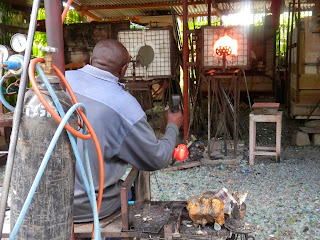Even with the planning I’ve been doing this week, I was able
to take a trip to visit another school owned by the Diocese of Central
Tanganyika. Bishop Stanway Primary
School is an English Medium school situated on the outskirts of Dodoma. It’s actually a good distance away from
CAMS. Being an English Medium school
only means that the instruction is all done in English, rather than
Swahili. Most government schools in
Tanzania teach in Swahili until secondary, when all instruction is done in
English. It is not however an
international school such as CAMS, so all the staff and students are Tanzanian. I was really excited to be able to visit to
see what a Tanzanian school is like.
I also had a secondary motive for my visit. The Foundation for the Episcopal Church in
Wyoming, along with the congregation in Big Piney are supporting the school
through some scholarships and building grants.
Since I am a lot closer than they are, I was asked to stop in and check
it out for them, which I was more than happy to do!
As it turns out, Maria and I have a mutual connection to the
school. She is part of an organization
in the UK that is also supporting a program at the school. She was able to set up our visit, which was
really helpful as she had actually been there before. We realized once we got there how closely our
respective organizations were working with each other without even knowing
it.
We first stopped in the dormitory area and were greeted by
several kids who were on their lunch break.
They were very excited to meet us.
BSPS provides both day and boarding school. There are 45 students who stay at the school
full time. Maria’s organization helps
provide for children of pastors to stay at the school, so she was able to talk
with them about how things were going.
Then, we got a tour of the dormitories.
The 45 students stay in bunk beds in the 4 rooms. Both of our organizations have helped
here. Originally, the students shared
beds. Now they each get their own
bunk. Mosquito netting has been
provided, but there aren’t enough to go around.
Malaria has been a problem with some of the children, which is most
likely due to this problem. Interestingly,
the mosquitoes that carry malaria are most likely to bite at night, which is
why mosquito nets are one of the most effective preventative measures that are
taken against the illness. Mosquito nets
are easy to find in Tanzania, so this shouldn’t be a problem for much longer!
All the food provided for the children is cooked outside
over a wood fire. This is very common in
Tanzania. The area where the food is
prepared and cooked is a three walled structure with a roof. To American eyes, it would look out of place
as a place to prepare food, but it fits right in here in Tanzania!
After we finished at the dormitory area, we walked the short distance to the school. The school buildings are set up so that there are two classrooms in each, with a small office area between the two.
Part of the grant money supplied by the Foundation has paid for 100 desks and chairs for the school. Two of the classrooms are being repaired and these desks are waiting for the floors to be finished before going in the classrooms.
Some of the children outside during break. The building in the distance is the toilets. New toilets are being planned which will be closer to the classrooms.
























































